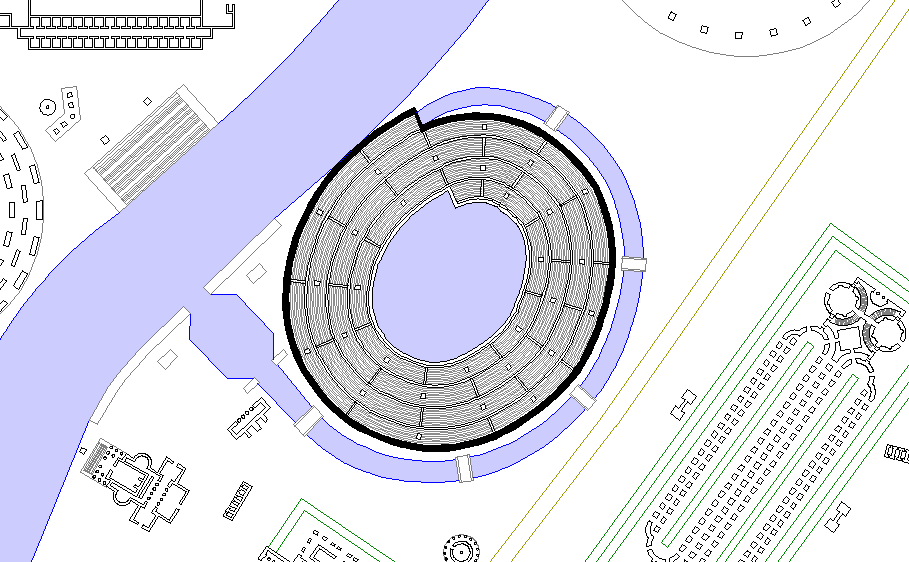
Naumachia Domitiani
Ostium Euripi cum januis aperiendis et claudendis ad adjendas et elevandes naves ex inferiori profluente Tiberis in superioremsuperficiem aquae Naumachiae
--text labeling the sluice feeding the euripus surrounding and leading into the Naumachia Domitiani.
Domitian built a second naumachia on this side of the river, and Philippus Arabs still a third. It is probable that the naumachia of Domitian was situated northwest of the mausoleum of Hadrian, in the district called regio naumachiae in the middle ages, where remains of such a structure have been found.
Platner
Vincenzo Fasolo, "The Campo Marzio of G. B. Piranesi".
2691a
1956
Tafuri text
1996.09.02
1998.12.01
Cochlearum Hirpini
On purely literal terms, there is a connection between the word cochlea - spiral - and the Naumachia Domitiani's spiral formation. Otherwise, Piranesi may be making some kind of "inverted" joke regarding the swiftness of the Equirian horse-races and the slowness of snails.
1998.12.01
Equiria
The buildings along the Equiria related to the military are: the Officinae Balistarium, the Officinae Scorpiorium, the Templum Castrum, the Naumachia Domitiani, three Circulus with two Ludus, the Officinae Armorum with its attached Officinae machinarum militarium, the Templa Jovis Martis Veneris, and an Aedicula Isidis, all of which translate into a ballista factory, a scorpion factory, a temple dedicated to Castor (the guide to mariners), a stadium for the show of mock sea-fights, exercise fields, a factory for arms and military machines, and a triple temple dedicated to Jupiter, Mars, and Venus and chapel dedicated to Isis. These buildings, moreover, are interspersed with "statues of illustrious men" as well as the sepulchers of many distinguished military figures from Roman history. This concentration of military functions essentially constitutes a design for ancient Rome's main military headquarters.
Porticus Alexandri Severi
Porticus Vipsania
Templum Castorum
1998.12.01
Ichnographia Quondam
13120205 IQ05
| |
2013.12.13 19:48
I wonder if Piranesi's spiraling mock sea-battle stadium within the Ichnographia Campus Martius, the Naumachia Domitiani, will become the inspiration for a new stadium designed within the next decade or so.
Mars (Martis)
1998.07.23
Another of the Ichnographia's three major axes is the race course of the Equiria, the annual horse races held in honor of Mars. Piranesi delineates the course as a relatively straight path running the length of the Ichnographia's northern sector, beginning in the south at the Petronia Amnis (which is, however, incorrectly placed within the plan) and ultimately reaching the outskirts of Rome at the plan's edge. With the exception of a few private gardens on a hill overlooking the Equiria, all the structures along the course relate directly to the Equiria or to the military in general. Three long porticos, the Porticus a S.P.Q.R. Amoenitati Dicata, the Porticus Vipsania, and the Porticus Alexandri Severi, line the course, and no doubt are meant to accommodate the spectators of Rome's premier "fest". The buildings and areas related to the military include, the Officinae Balistarium (manufactory of ballista), Officinae Scorpiorum (manufactory of scorpions), the Naumachia Domitiani (a large amphitheater designed for the show of mock naval battles), three Circulus (large circular areas for military drills and exercises, and finally the Officinae Armorum and the Officinae machinarum militarium (manufactories of military arms and machines). Not only do these buildings pay respect to Mars as the god of war, but, as a cohesive group, they essentially constitute Rome's "Department of Defense".
| |
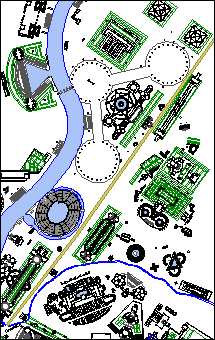
The Equiria (the broad gold line running from the lower left corner to the upper right corner) spans the Ichnographia's northern region, and the course itself runs in an almost true north-south direction.
|
|
| |
Naumachia Domitiani
1998.12.01
naumachia : a place where mock sea-fights were exhibited
Domitianus : a Roman emperor, son of Vespasian and brother of Titus, who reigned 81-96 AD
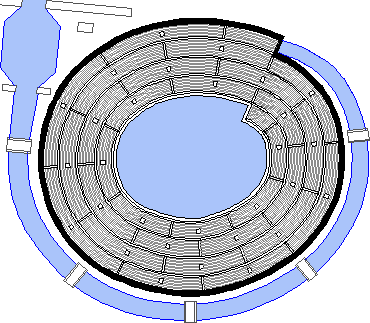
The Naumachia Domitiani is truly a unique amphitheater because of its unprecedented spiral versus concentric formation. Rather than set in concentric tiers, this naumachia's grandstands form a continuous spiral ramp, beginning at the lowest seats and ending at the highest. The spiral design is further reinforced by the surrounding canal, which feeds from the Tiber to the naumachia's aquatic stage, and Piranesi would have us believe the canal concealed under the stadium continues in a spiral path because he indicates the water's stage-entrance at the step in the stage perimeter's oval.
The Naumachia Domitiani, like the Porticus Vipsania and the Porticus Alexandri Severi, is one of the buildings along the Ichnographia's Equiria that represents an actual ancient Roman building. According to Suetonius, the emperor Domitian ordered the digging of a lake, "close to the Tiber, surrounded with seats, and used for almost full-scale naval battles."¹ Domitian's naumachia did not last long however, because it's stones were later used to repair fire damage at the Circus Maximus. Since there is no archeological record of the lake's actual site along the Tiber, Piranesi's position of the Naumachia Domitiani is therefore discretionary at best. Likewise, with no record of the real naumachia's design, Piranesi's spiral amphitheater reflects Piranesi's own architectural imagination rather than historical substantiality. Nevertheless, the Naumachia Domitiani plays an important role within the planned military program of the Ichnographia's Equiria.
Situated approximately one-third up the one and a half mile race-course, the Naumachia Domitiani, through its massiveness and presumed height alone, is a prominent presence along the Equiria. Piranesi also positions the Naumachia Domitiani together with the Templum Castorum and the Templum Deorum Larium Parmarini, which consequently forms a group of buildings dedicated to ancient Rome's naval military forces. Like the Equiria, the Naumachia Domitiani is a showplace, however, where the Equiria is for a horse-race on land, the Naumachia is for a battle at sea. This contrast in "martial" display, moreover, is deftly accentuated by the rigid linearity of the Equiria versus the spiral curvature of the Naumachia and its surrounding canal. Hence, the Equiria and the Naumachia Domitiani together represent the overall amphibious nature² of ancient Rome's military forces.
| |
Catalogo reference:
Naumachia di Domiziano «Sueton. Domiziano al cap. 4 . Marzial. su la medesima e nel lib. 1 epigr. 24.» Si referisce nel cap. VI. art V.
1. Suetonius, The Twelve Caesars, trans. Robert Graves (London: Penguin Books, 1979), p 301-2.
2. The presence of "amphibious nature" along the Equiria is also found in the Cochlearum Hirpini, a pen in which snails are kept and fed that sits at the Equiria's northern-most end, and, in its ichnography, the spiral formation of the Naumachia Domitiani is also evocative of a snail.
|
2011.01.31 11:36
READING LIST
After finishing "Instrauratio Urbis" a second time this morning, I then got out Bufalini's map again, and made another discovery--the 'O' of ROMA along the top of [Nolli's re-engraving of] Bufalini's map corresponds with Piranesi's placement of the spiraling oval of the Naumachia Domitiani. Piranesi is probably laughing right now.
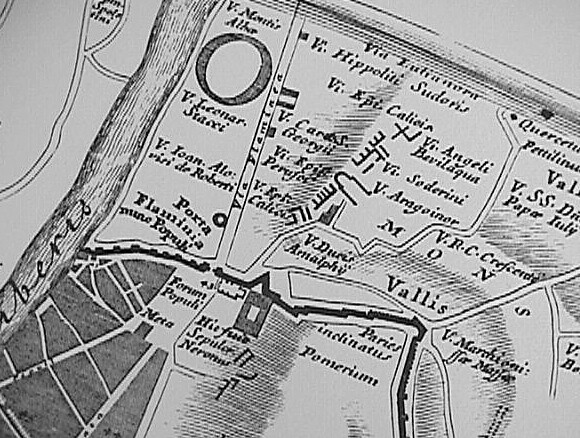 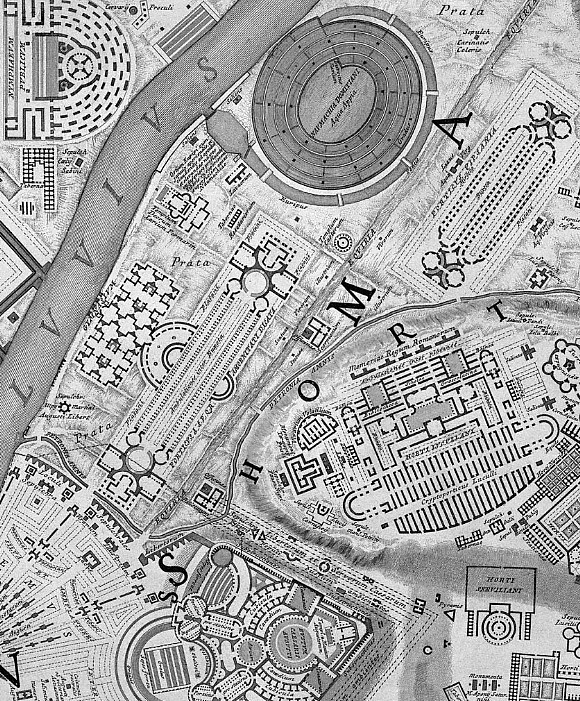
And today, 31 January 2013, I see how the scant ruin labeled V. Aragoiner within Bufalini's map spurred Piranesi's design of the Horti Lucullani.
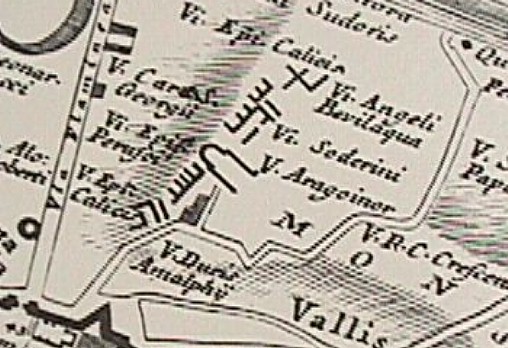 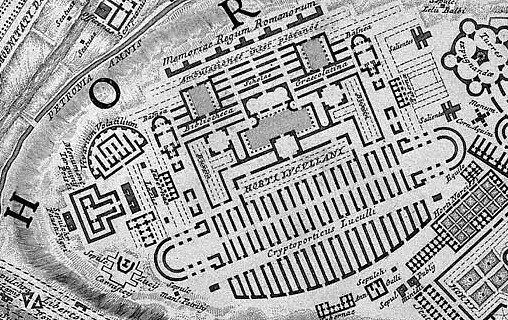
|






